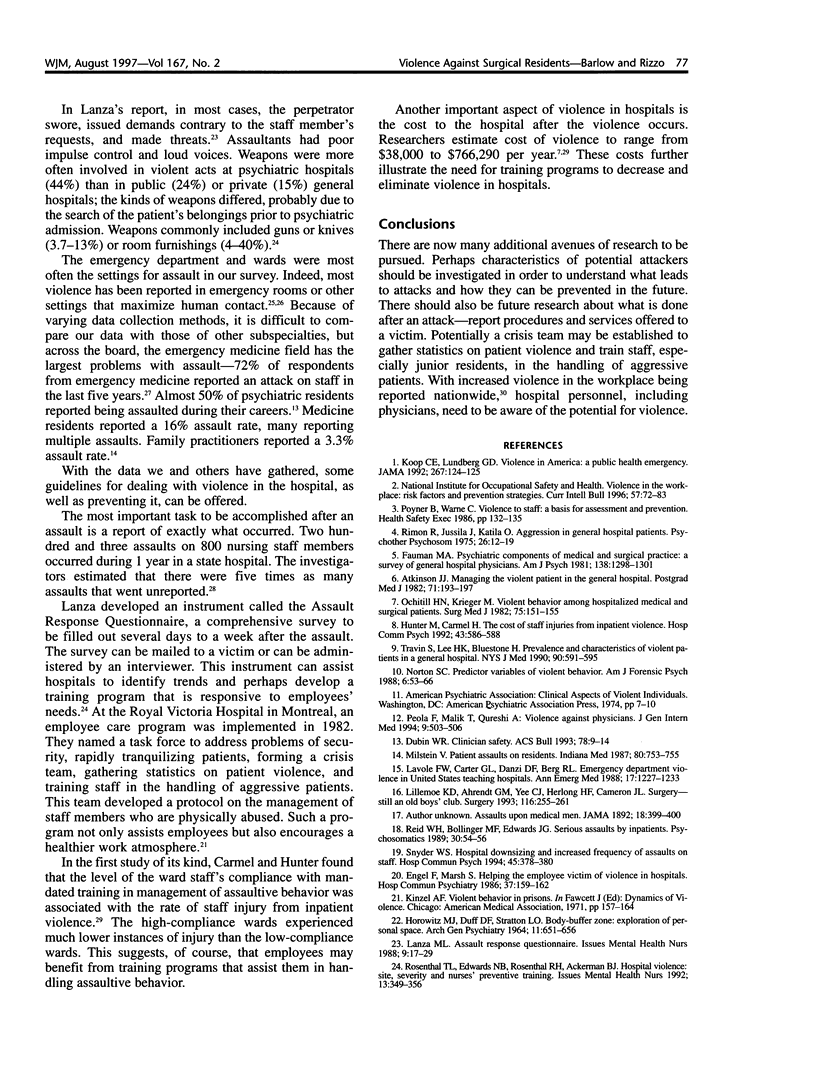Abstract
Violence against hospital personnel is underreported (less than one in five assaults), and accurate statistics as to the rate of violence against hospital personnel are thus difficult to establish. In the psychiatric discipline, an abundance of information has been published regarding violence in the health care setting, but few studies have examined violence outside psychiatric hospitals or by patients not diagnosed with psychiatric ailments. Using a survey that elicits information about workplace violence, we sought to gauge the prevalence of violent acts affecting general hospital workers who treat victims of violence on a daily basis. The survey was completed by a cohort of surgical staff nationwide (475 responses from 57 residency programs). Two hundred and eighty residents reported having witnessed one or more physical attacks, and 179 reported having been attacked. Violent acts were more likely to be committed in a public hospital than a private institution (P = 0.05). As shown in previous research, most attacks occurred in the emergency room (P = 0.01); the wards and parking lot were next in frequency. Women residents were more likely than men to call hospital security to intervene in a potentially violent situation (P = 0.04), and junior residents (postgraduate years 1-4) were more likely to be attacked than senior residents (> or = 5 years) (P = 0.04). The attacker was most likely to be a young black male between ages 19 and 30 (P = 0.01). We found no statistical relationship between the attacker and the victim regarding sex or race. Of the 475 respondents, 470 reported that they carry a gun themselves or know someone in the hospital environment who carries a gun.
Full text
PDF




Images in this article
Selected References
These references are in PubMed. This may not be the complete list of references from this article.
- Atkinson J. H., Jr Managing the violent patient in the general hospital. Postgrad Med. 1982 Jan;71(1):193-7, 200-1. doi: 10.1080/00325481.1982.11715969. [DOI] [PubMed] [Google Scholar]
- Carmel H., Hunter M. Compliance with training in managing assaultive behavior and injuries from inpatient violence. Hosp Community Psychiatry. 1990 May;41(5):558–560. doi: 10.1176/ps.41.5.558. [DOI] [PubMed] [Google Scholar]
- Dubin W. R. Clinician safety. A synopsis of the report of the American Psychiatric Association Task Force on Clinician Safety. Bull Am Coll Surg. 1993 Aug;78(8):9–14. [PubMed] [Google Scholar]
- Engel F., Marsh S. Helping the employee victim of violence in hospitals. Hosp Community Psychiatry. 1986 Feb;37(2):159–162. doi: 10.1176/ps.37.2.159. [DOI] [PubMed] [Google Scholar]
- Fauman M. A. Psychiatric components of medical and surgical practice: a survey of general hospital physicians. Am J Psychiatry. 1981 Oct;138(10):1298–1301. doi: 10.1176/ajp.138.10.1298. [DOI] [PubMed] [Google Scholar]
- HOROWITZ M. J., DUFF D. F., STRATTON L. O. BODY-BUFFER ZONE; EXPLORATION OF PERSONAL SPACE. Arch Gen Psychiatry. 1964 Dec;11:651–656. doi: 10.1001/archpsyc.1964.01720300081010. [DOI] [PubMed] [Google Scholar]
- Hunter M., Carmel H. The cost of staff injuries from inpatient violence. Hosp Community Psychiatry. 1992 Jun;43(6):586–588. doi: 10.1176/ps.43.6.586. [DOI] [PubMed] [Google Scholar]
- Lanza M. L. Assault response questionnaire. Issues Ment Health Nurs. 1988;9(1):17–29. doi: 10.3109/01612848809140907. [DOI] [PubMed] [Google Scholar]
- Lavoie F. W., Carter G. L., Danzl D. F., Berg R. L. Emergency department violence in United States teaching hospitals. Ann Emerg Med. 1988 Nov;17(11):1227–1233. doi: 10.1016/s0196-0644(88)80076-3. [DOI] [PubMed] [Google Scholar]
- Lavoie F. W., Carter G. L., Danzl D. F., Berg R. L. Emergency department violence in United States teaching hospitals. Ann Emerg Med. 1988 Nov;17(11):1227–1233. doi: 10.1016/s0196-0644(88)80076-3. [DOI] [PubMed] [Google Scholar]
- Lillemoe K. D., Ahrendt G. M., Yeo C. J., Herlong H. F., Cameron J. L. Surgery--still an "old boys' club"? Surgery. 1994 Aug;116(2):255–261. [PubMed] [Google Scholar]
- Lion J. R., Synder W., Merrill G. L. Underreporting of assaults on staff in a state hospital. Hosp Community Psychiatry. 1981 Jul;32(7):497–498. doi: 10.1176/ps.32.7.497. [DOI] [PubMed] [Google Scholar]
- Milstein V. Patient assaults on residents. Indiana Med. 1987 Aug;80(8):753–755. [PubMed] [Google Scholar]
- Ochitill H. N., Krieger M. Violent Behavior among hospitalized medical and surgical patients. South Med J. 1982 Feb;75(2):151–155. doi: 10.1097/00007611-198202000-00008. [DOI] [PubMed] [Google Scholar]
- Paola F., Malik T., Qureshi A. Violence against physicians. J Gen Intern Med. 1994 Sep;9(9):503–506. doi: 10.1007/BF02599220. [DOI] [PubMed] [Google Scholar]
- Reid W. H., Bollinger M. F., Edwards J. G. Serious assaults by inpatients. Psychosomatics. 1989 Winter;30(1):54–56. doi: 10.1016/s0033-3182(89)72317-3. [DOI] [PubMed] [Google Scholar]
- Rimón R., Jussila J., Katila O. Aggression in general-hospital patients. Psychother Psychosom. 1975;26(1):12–19. doi: 10.1159/000286890. [DOI] [PubMed] [Google Scholar]
- Rosenthal T. L., Edwards N. B., Rosenthal R. H., Ackerman B. J. Hospital violence: site, severity, and nurses' preventive training. Issues Ment Health Nurs. 1992 Oct-Dec;13(4):349–356. doi: 10.3109/01612849209010315. [DOI] [PubMed] [Google Scholar]
- Snyder W., 3rd Hospital downsizing and increased frequency of assaults on staff. Hosp Community Psychiatry. 1994 Apr;45(4):378–380. doi: 10.1176/ps.45.4.378. [DOI] [PubMed] [Google Scholar]
- Travin S., Lee H. K., Bluestone H. Prevalence and characteristics of violent patients in a general hospital. N Y State J Med. 1990 Dec;90(12):591–595. [PubMed] [Google Scholar]



